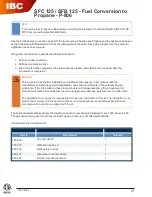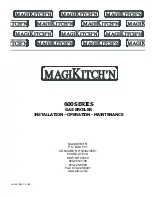
HAMWORTHY HEATING LTD
38
FLEET V series
500001213/G
10 SERVICING
A competent person registered for working on non
domestic gas appliances should check and ensure that
the flue, its support and terminal, the ventilation to the
boiler house, safety valve, drain, water filter if fitted,
pressure gauge, etc.; are in a serviceable and working
condition and still comply with the relevant standards
and codes of practice - see
Section 4.
10.1 Regular servicing is recommended
, preferably
by a Hamworthy appointed person, and at least
annually, to ensure trouble free operation.
For Fleet boilers, Hamworthy would recommend an
additional 6 monthly examination following
commissioning, acknowledging site conditions and
running hours.
Although cleaning of flueways may not be necessary on
a yearly basis, it is important that all controls and safety
features are checked for correct operation.
Note:-
Measuring flue gas CO
2
and gas temperatures
will give an indication of the state of the boiler flueways
and waterways. Results should be compared with
previously measured values to establish possible loss of
efficiency.
10.2 Annual Service
Before servicing the boiler, the following procedure must
be carried out :-
WARNING: Isolate all electrical supplies and turn off
the gas service valve.
1)
Open the front casing by turning the 1/4 turn latches
with a flat bladed screw driver. Note the latch
mechanism passes through slots in the chassis top and
bottom.
Once removed access is gained to the controls panel,
the heat exchanger components and the combustion
system assembly.
2)
Disconnect the H.T and flame probe connectors from
the respective probes.
3)
Disconnect the fan power supply and control leads
from the fan taking care with the latch on each
connector.
4)
Check that the gas service valve is closed, then undo
the compression union on the inlet to the gas valve.
5)
Carefully disengage the flexible air inlet duct from the
venturi and remove the electrical plug from the gas
valve.
6)
Remove the 3 M6 socket head screws securing the
fan /burner duct assembly to the heat exchanger and
carefully remove the assembly and the sealing gasket.
Carefully remove the burner from the heat exchanger,.
7)
Remove and inspect H.T. electrode and flame probe,
ensure they are free from debris or deposits. – See
Figures 10.2. 10.2.1 & 10.2.2
8)
Check the burner and clean using a soft brush if
required (if possible use a vacuum cleaner to remove
the dust from inside the burner tube). After cleaning the
inside, the burner tube can be washed using a soapy
water solution. Tap the burner flange firmly downwards
on a block of wood to dislodge any residual debris from
inside the burner tube. A damaged or cracked burner
should be replaced.
Note:-
Do not use a wire brush to clean the burner.
9)
Carefully remove the insulation pad from the heat
exchanger back plate (accessed through the burner
cavity) and replace with a new pad ensuring the edges
are ‘tucked in’ to the gap past the last section
9)
Separate the gas valve / venturi from the fan inlet
noting it’s orientation and inspect the fan scroll and
impellor, clean and check for damage.
10)
Clean and check the venturi for contamination.
11)
Remove the fan from the burner duct and inspect
the non return valve in the duct for smooth operation.
12)
Separate the inlet flange /elbow fitting from the gas
control valve by removing the 4 M5 socket cap head
screws. Check that the mesh inlet filter in the gas valve
is clear of debris, remove any foreign objects caught in
the filter.
Re-assemble in reverse order taking care to inspect and
if necessary, replace any o-rings, gaskets or seals.
Refer to
Section 8, Commissioning and Testing
, and
test all gas joints broken or disturbed for soundness
before firing.
Carry out a combustion check by testing the flue gas
CO
2
and CO levels as detailed in
Section 8.2.
10.3 Four Year Service
Repeat the annual service as previously described but
do not refit any components to the heat exchanger.
Isolate the boiler flow and return connections from the
heating system.
10.3.1
To clean the heat exchanger, the use of a high
pressure water hose (40-80 psi) is recommended for
the primary flue gas path. However provision must be
made for the drainage of water used in this process. At
the rear of the boiler remove the condensate drain trap
assembly from the flue elbow. Connect a hose (32mm
id.) to the flue elbow and take to a suitable drain or
receptacle. The cleaning water and any debris will exit
the sump through this opening.
To clean the condensing flue gas path, isolate the boiler
from the heating system and drain the boiler heat
exchanger using the drain valve provided in the return
pipe. Disconnect the electrical supply to the pump,
return sensor and the flow switch. Carefully support the
pump, disconnect the unions and remove the pump.
Remove the 2 M6 screws securing the return elbow /
pipe assembly to the heat exchanger and carefully
remove the assembly.
Remove the 4 screws (M8) securing the heat
exchanger assembly to the chassis backplate.
Disconnect the heat exchanger flow connection from
the heating system and the flue pipe from the sump
elbow and carefully slide the heat exchanger assembly
Содержание F40V
Страница 2: ......
Страница 31: ...HAMWORTHY HEATING LTD 25 FLEET V series 500001213 G Figure 8 2 1 3 Operation and display philosophy...
Страница 40: ...HAMWORTHY HEATING LTD 34 FLEET V series 500001213 G Figure 8 3 11 Operating phases...
Страница 63: ...HAMWORTHY HEATING LTD 57 FLEET V series 500001213 G NOTES...
Страница 65: ...Please complete the information on the Registration Card cut out and return to Hamworthy Heating Ltd...
Страница 66: ......
Страница 67: ......
















































